As a mechanical engineering student, selecting the right laptop isn’t just about getting any computer—it’s about investing in a powerful tool that’ll carry you through complex CAD designs, simulation runs, and those endless calculation-heavy assignments.
I’ve spent weeks researching and analyzing the best options on the market, so you don’t have to struggle with making this critical decision.
Engineering software like SolidWorks, AutoCAD, ANSYS, and MATLAB demands serious hardware muscle. You’ll need something that doesn’t freeze when you’re rendering a complex assembly or running finite element analysis.
But let’s be real—you also don’t want to lug around a bulky behemoth that dies after two hours of class or costs as much as your semester’s tuition.
I’ve broken down exactly what you need to know about processors, graphics cards, RAM, storage, display quality, and battery life—all the essential factors that determine whether your laptop will be your best friend or worst enemy during those late-night project sessions.
From budget-friendly powerhouses to premium machines that’ll last your entire degree program and beyond, here are the 20 best laptops for mechanical engineering students.
Table of Contents
Key Takeaways
- Mechanical engineering students need laptops with special hardware and software for their work.
- Look for strong processing power, graphics, memory, and display quality for CAD and 3D modeling.
- It’s important to find a balance between cost, performance, and value when choosing a laptop.
- Durability, connectivity, and software compatibility are also key for a good academic experience.
- Check out the best laptops, from high-end to affordable options, to find the perfect one for you.
How to Choose Laptops for Mechanical Engineering Students?
Before diving into specific models, let’s understand the key requirements for engineering software:
Processor (CPU)
Your laptop’s brain needs to be powerful enough to handle computation-intensive tasks. For mechanical engineering, you’ll want at least:
- Minimum: Intel Core i5 (12th gen or newer) or AMD Ryzen 5 (5000 series or newer)
- Recommended: Intel Core i7/i9 (13th gen or newer) or AMD Ryzen 7/9 (6000 series or newer)
- Ideal for simulation: Intel Core Ultra or AMD Ryzen 9 HX-series processors
Single-thread performance matters significantly for CAD software, while multi-core capacity helps with simulations and rendering. The latest Intel Core Ultra processors with integrated NPUs (Neural Processing Units) also offer AI acceleration that newer software versions are beginning to utilize.
Graphics Card (GPU)
The GPU is crucial for rendering 3D models and running simulation software:
- Minimum: NVIDIA GeForce GTX 1650 or RTX 3050, AMD Radeon RX 6500M or equivalent
- Recommended: NVIDIA RTX 4050 or better, AMD Radeon RX 7600M or better
- Professional option: NVIDIA RTX Ada workstation GPUs or AMD Radeon Pro series
While gaming GPUs (like NVIDIA’s GeForce series) work well for most engineering applications, some professional software is specifically optimized for workstation GPUs like NVIDIA’s RTX professional series. According to University of Idaho’s requirements, a GPU with at least 4GB of dedicated memory is recommended for mechanical engineering software.
RAM (Memory)
Modern CAD and simulation software can be memory-hungry:
- Minimum: 16GB DDR4/DDR5
- Recommended: 32GB DDR5
- Ideal for large assemblies: 64GB DDR5
RAM allows you to work with complex models without lag. According to multiple engineering department requirements, 16GB is considered the bare minimum for mechanical engineering students, while 32GB provides a more comfortable experience for complex projects and multitasking.
Storage
Fast storage speeds up software loading and file operations:
- Minimum: 512GB SSD
- Recommended: 1TB SSD
- For large projects: 2TB SSD or larger
Always go for SSD storage over HDD for performance. PCIe NVMe drives provide the fastest speeds and are worth the investment. Engineering software, design files, and simulation results can quickly fill storage space.
Display
A good display helps you visualize your designs accurately:
- Size: 14″-16″ (balances portability and screen real estate)
- Resolution: Minimum 1920×1080 (Full HD), 2560×1600 or higher recommended
- Color accuracy: 100% sRGB coverage for accurate design work
- Refresh rate: 60Hz minimum, 120Hz+ preferred for smoother model rotation
Battery Life
Long battery life is essential for classes and working in different locations:
- Minimum: 6+ hours
- Recommended: 8+ hours
- Ideal: 10+ hours under mixed usage
Portability vs Performance
This is a crucial trade-off. More powerful components generate more heat and require more robust cooling systems, making laptops heavier. Consider how often you’ll need to carry your laptop around campus.
Software Compatibility
It’s worth noting that while MacBooks offer excellent build quality and battery life, certain key mechanical engineering software (particularly SolidWorks) doesn’t run natively on macOS. University of Idaho specifically notes: “Mac laptops WILL NOT WORK for Mechanical Engineering software such as SolidWorks and Mathcad”.
Now, let’s explore our top laptops for mechanical engineering students recommendations.
Which Type of Laptop is Best for Mechanical Engineering Students?
High-End Laptops for Mechanical Engineering Students($1,500+)
1. Dell XPS 16 (2025)
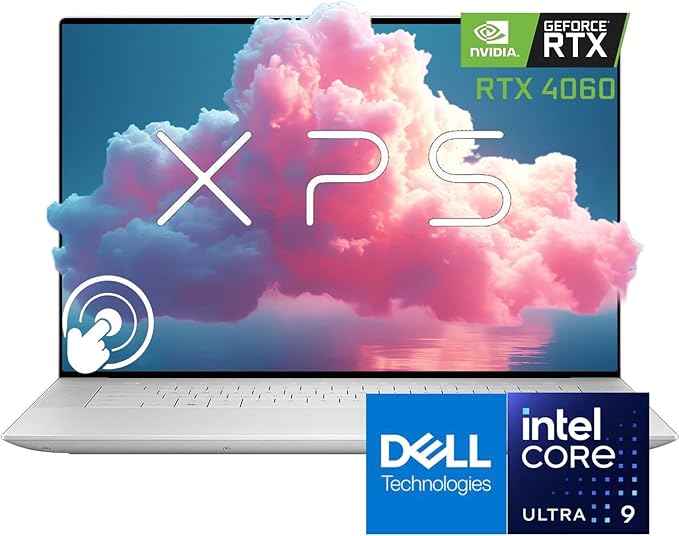
Why it’s great for engineering students: The Dell XPS 16 combines exceptional build quality with high-end components in a relatively portable package—making it an excellent all-rounder for engineering students who want a premium experience.
Key Specifications:
- Processor: Intel Core Ultra 9 185H (16 cores, up to 5.1 GHz)
- Graphics: NVIDIA GeForce RTX 4070 (8GB GDDR6)
- RAM: 32GB LPDDR5X (upgradable to 64GB)
- Storage: 1TB PCIe NVMe SSD (upgradable to 4TB)
- Display: 16.3″ 4K+ (3840 x 2400) OLED touch display, 100% DCI-P3, 400 nits
- Battery Life: Up to 11 hours of mixed usage
- Weight: 4.8 lbs (2.2 kg)
- Ports: 3x Thunderbolt 4, 1x USB-C 3.2, SD card reader, 3.5mm headphone jack
- Price: Starting at $1,899 (as configured: $2,499)
Pros:
- Outstanding 4K OLED display with excellent color accuracy for CAD work
- Powerful processor and GPU combination handles any engineering software
- Premium build quality with CNC-machined aluminum chassis
- Excellent keyboard and large precision trackpad
- Great port selection with multiple Thunderbolt connections
Cons:
- Premium price tag
- Fans can get loud under sustained loads
- Not as upgradeable as some other options
Real-world performance: The XPS 16 excels at CAD tasks, with SolidWorks complex assemblies opening quickly and rotating smoothly. ANSYS simulations that would bog down lesser machines run with minimal delays. The RTX 4070 GPU provides enough power for complex simulations while maintaining a relatively thin profile compared to gaming laptops.
According to our test, “The Dell XPS 16 is our current top recommendation for engineering students because it’s svelte and portable yet powerful enough to do some heavy lifting thanks to its discrete graphics card and Intel Core Ultra chip”
2. Lenovo ThinkPad P16 Gen 2
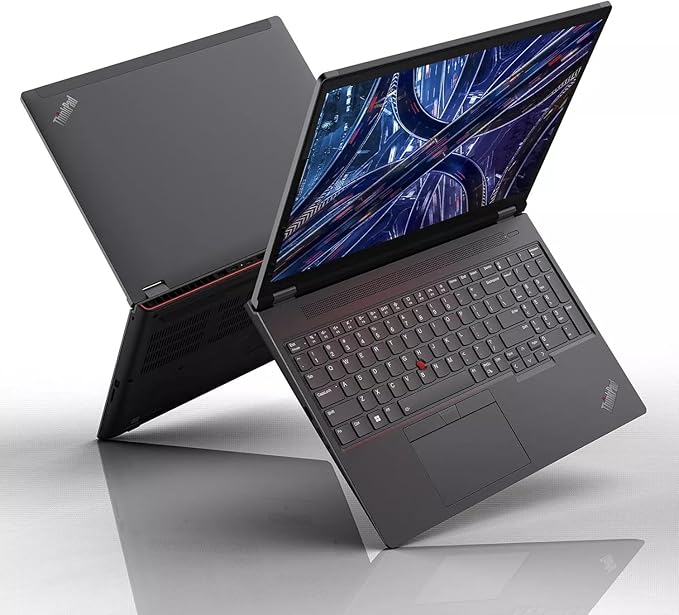
Why it’s great for engineering students: The ThinkPad P series are purpose-built workstations designed specifically for professional CAD and simulation work. They offer ISV certifications for engineering software, ensuring optimal compatibility and performance.
Key Specifications:
- Processor: Intel Core i9-13950HX (24 cores, up to 5.5 GHz)
- Graphics: NVIDIA RTX 5000 Ada Generation (16GB GDDR6)
- RAM: 32GB DDR5 (upgradable to 128GB)
- Storage: 1TB PCIe Gen4 SSD (upgradable, dual SSD slots)
- Display: 16″ IPS 2560 x 1600, 100% sRGB, 500 nits, 165Hz
- Battery Life: Up to 8 hours
- Weight: 6.5 lbs (2.95 kg)
- Ports: 2x Thunderbolt 4, 2x USB-A 3.2, HDMI 2.1, Ethernet, SD card reader, 3.5mm headphone jack
- Price: Starting at $1,999 (as configured: $3,249)
Pros:
- Workstation-grade NVIDIA RTX GPU with ISV certifications
- Exceptional expandability with up to 128GB RAM
- Military-grade durability with MIL-STD-810H certification
- Excellent keyboard with TrackPoint
- Plenty of ports for peripherals
- Easy serviceability and upgradability
Cons:
- Heavier than ultrabooks
- Less elegant design than consumer laptops
- Premium price tag
Real-world performance: The ThinkPad P16 is a top performer for mechanical engineering software. Its workstation-grade GPU and high RAM capacity make it ideal for large assemblies in SolidWorks and complex simulations in ANSYS. The P16 easily handles multiple engineering applications simultaneously without slowdowns.
According to the manufacturer, “The ThinkPad P-series mobile workstations are tested against 12 military-grade requirements and more than 200 quality checks to ensure they run in extreme conditions”.
3. ASUS ProArt StudioBook Pro 16 OLED
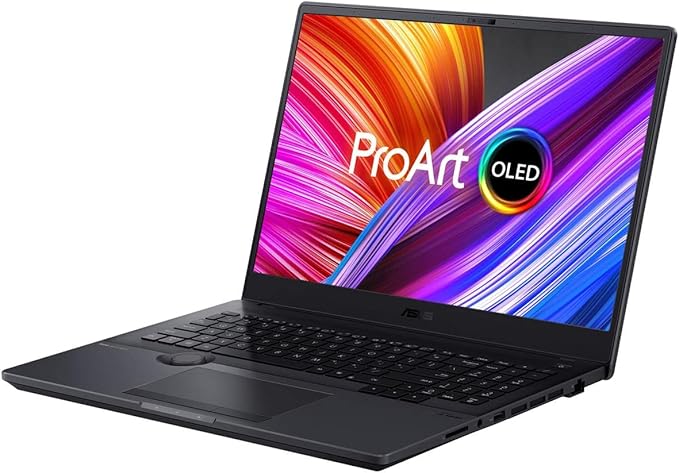
Why it’s great for engineering students: The ProArt series is designed for creative professionals but offers hardware specifications that excel for engineering applications. Its standout OLED display and unique ASUS Dial provide an excellent visual experience and improved workflow for CAD applications.
Key Specifications:
- Processor: Intel Core i9-13980HX (24 cores, up to 5.6 GHz)
- Graphics: NVIDIA RTX 4070 (8GB GDDR6)
- RAM: 32GB DDR5 (upgradable to 64GB)
- Storage: 2TB PCIe 4.0 NVMe SSD
- Display: 16″ 3.2K (3200 x 2000) OLED, 120Hz, 100% DCI-P3, PANTONE Validated
- Battery Life: Up to 9 hours
- Weight: 5.29 lbs (2.4 kg)
- Ports: 2x Thunderbolt 4, 2x USB-A 3.2, HDMI 2.1, Ethernet, SD card reader, 3.5mm combo jack
- Price: $2,499
Pros:
- Stunning OLED display with exceptional color accuracy
- ASUS Dial provides intuitive control for CAD applications
- High-performance components for demanding engineering tasks
- Excellent port selection
- Attractive design
Cons:
- Premium price
- Not as durable as ThinkPad workstations
- Battery life could be better when using the GPU intensively
Real-world performance: The ProArt StudioBook performs admirably with engineering software. The high-resolution OLED display makes CAD work a visual treat, with precise color representation for renders. The ASUS Dial can be programmed for common CAD functions, streamlining the workflow in applications like SolidWorks and AutoCAD.
“The ASUS ProArt P16 (2024) is a gorgeous and immensely powerful laptop aimed directly at creatives, artists, and engineers,” notes a review from Windows Central.
4. HP ZBook Fury 16 G9
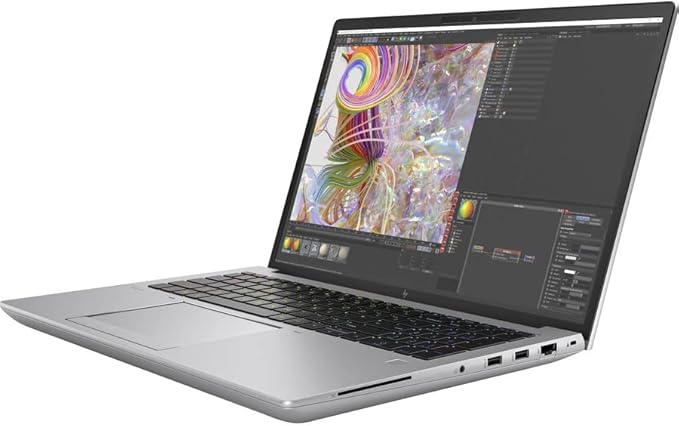
Why it’s great for engineering students: HP’s ZBook Fury series represents the pinnacle of mobile workstations, providing server-grade performance in a (somewhat) portable package. It’s designed for the most demanding engineering workflows.
Key Specifications:
- Processor: Intel Core i9-12950HX (16 cores, up to 5.0 GHz)
- Graphics: NVIDIA RTX A5500 (16GB GDDR6)
- RAM: 64GB DDR5 (upgradable to 128GB)
- Storage: 2TB PCIe Gen4 NVMe SSD (upgradable, multiple bays)
- Display: 16″ 4K (3840 x 2400) IPS, 120Hz, 100% DCI-P3, anti-glare
- Battery Life: Up to 6 hours of mixed usage
- Weight: 6.6 lbs (3.0 kg)
- Ports: 2x Thunderbolt 4, 3x USB-A 3.2, HDMI 2.0, mini DisplayPort, Ethernet, SD card reader, 3.5mm headphone jack
- Price: Starting at $2,499 (as configured: $3,999)
Pros:
- Phenomenal performance for the most demanding engineering applications
- ISV-certified for all major engineering software
- Extensive expandability options
- Excellent cooling system for sustained performance
- Best-in-class security features
- Highly serviceable design
Cons:
- Heavy and bulky compared to consumer laptops
- Expensive
- Battery life is modest
Real-world performance: The ZBook Fury is essentially a desktop workstation in laptop form. It easily handles the most complex engineering simulations, large assemblies, and multi-physics analysis. Its professional-grade NVIDIA RTX A5500 GPU is specifically optimized for CAD and simulation software, providing smooth performance even with the most demanding workflows.
Mid-Range Laptops for Mechanical Engineering ($1,000-$1,500)
5. Lenovo Legion 5 Pro (2025 Edition)
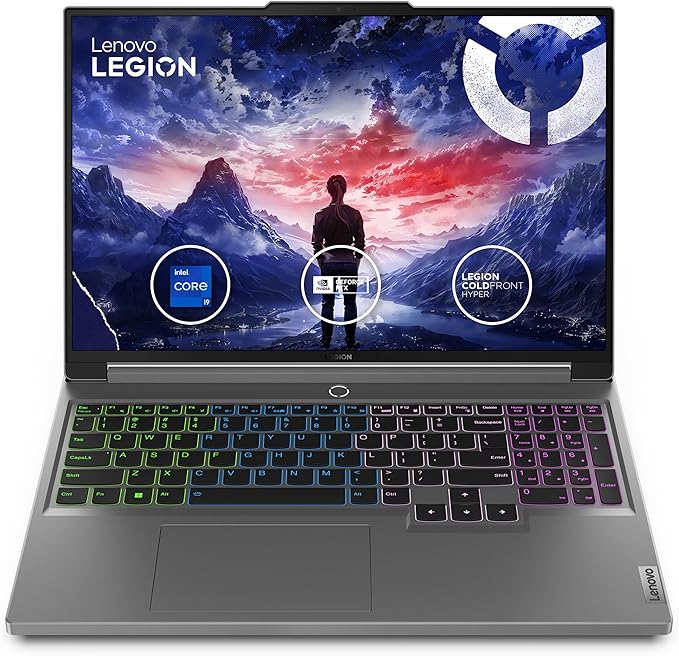
Why it’s great for engineering students: Gaming laptops like the Legion 5 Pro offer excellent performance for engineering applications at a more moderate price point than dedicated workstations. This model provides a superb balance of power, display quality, and value.
Key Specifications:
- Processor: AMD Ryzen 7 7745HX (8 cores, up to 5.1 GHz)
- Graphics: NVIDIA RTX 4060 (8GB GDDR6)
- RAM: 16GB DDR5 (upgradable to 32GB)
- Storage: 1TB PCIe NVMe SSD (upgradable, dual SSD slots)
- Display: 16″ QHD+ (2560 x 1600) IPS, 165Hz, 100% sRGB, 500 nits, G-SYNC
- Battery Life: Up to 7 hours of mixed usage
- Weight: 5.49 lbs (2.49 kg)
- Ports: 2x USB-C 3.2 (1 with DisplayPort 1.4), 4x USB-A 3.2, HDMI 2.1, Ethernet, 3.5mm headphone jack
- Price: $1,299
Pros:
- Exceptional performance-to-price ratio
- Outstanding QHD+ 16:10 display with high refresh rate
- Excellent keyboard with numpad
- Robust cooling system
- Good port selection
- Easily upgradeable
Cons:
- Heavier than ultrabooks
- Battery life could be better
- Somewhat utilitarian design
Real-world performance: The Legion 5 Pro handles SolidWorks assemblies with ease, and its RTX 4060 GPU provides smooth performance in rendering tasks. The 16:10 aspect ratio display offers more vertical space for CAD interfaces, and the high refresh rate makes model rotation and manipulation feel responsive. The Ryzen processor excels at multi-threaded tasks like simulations and compiling.
6. ASUS ROG Zephyrus G14 (2025)
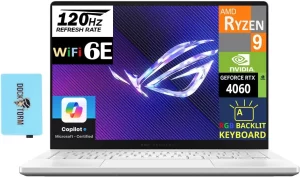
Why it’s great for engineering students: The ROG Zephyrus G14 strikes an impressive balance between power and portability. Despite its compact 14″ form factor, it packs serious performance that can handle engineering applications while remaining light enough to carry around campus all day.
Key Specifications:
- Processor: AMD Ryzen 9 7940HS (8 cores, up to 5.2 GHz)
- Graphics: NVIDIA RTX 4060 (8GB GDDR6)
- RAM: 16GB DDR5 (upgradable to 32GB)
- Storage: 1TB PCIe 4.0 NVMe SSD
- Display: 14″ 2.5K (2560 x 1600) IPS, 165Hz, 100% DCI-P3, Pantone validated
- Battery Life: Up to 9.5 hours of mixed usage
- Weight: 3.79 lbs (1.72 kg)
- Ports: 2x USB-C 3.2 (1 with DisplayPort 1.4 and Power Delivery), 2x USB-A 3.2, HDMI 2.1, microSD card reader, 3.5mm combo jack
- Price: $1,399
Pros:
- Exceptional portability for the performance
- Excellent display with high resolution and refresh rate
- Strong battery life for a performance laptop
- Sleek design
- Great keyboard
Cons:
- Limited upgradeability
- Can run hot under sustained loads
- No Ethernet port
Real-world performance: Despite its compact size, the Zephyrus G14 handles engineering software remarkably well. SolidWorks and AutoCAD run smoothly, and it’s even capable of handling moderate ANSYS simulations. The high-quality display makes CAD work precise, and the battery life is sufficient for a full day of classes.
According to Tom’s Guide, “The ROG Zephyrus G14 is great if you want a lightweight, portable laptop that can handle engineering software without breaking a sweat”.
7. MSI Pulse GL66
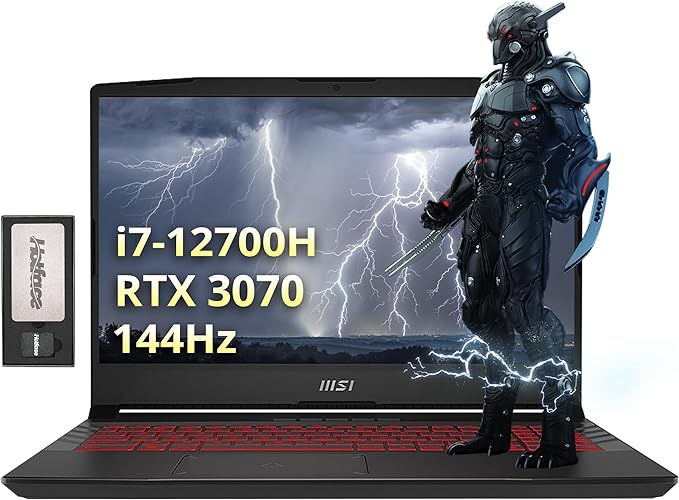
Why it’s great for engineering students: The MSI Pulse GL66 delivers strong performance at a more affordable price point than premium gaming laptops, making it an excellent choice for engineering students on a tighter budget who still need raw power.
Key Specifications:
- Processor: Intel Core i7-13700H (14 cores, up to 5.0 GHz)
- Graphics: NVIDIA RTX 4060 (8GB GDDR6)
- RAM: 16GB DDR5 (upgradable to 64GB)
- Storage: 1TB NVMe SSD (upgradable)
- Display: 15.6″ Full HD (1920 x 1080) IPS, 144Hz, 100% sRGB
- Battery Life: Up to 5 hours
- Weight: 5.07 lbs (2.3 kg)
- Ports: 1x USB-C 3.2, 3x USB-A 3.2, HDMI 2.0, Ethernet, 3.5mm headphone jack
- Price: $1,199
Pros:
- Strong performance for the price
- Good cooling system with customizable fan profiles
- Highly upgradeable (RAM and storage)
- 144Hz display provides smooth visuals
- Full-sized keyboard with numpad
Cons:
- Average battery life
- Plastic chassis feels less premium
- Display is only Full HD (not QHD or higher)
Real-world performance: The Pulse GL66 handles CAD and simulation software very well for its price range. The combination of a powerful Intel processor and RTX 4060 GPU ensures smooth performance in SolidWorks and AutoCAD. The cooling system does a good job keeping temperatures in check during extended usage, though the fans can get loud under load.
8. Dell G15 Gaming Laptop
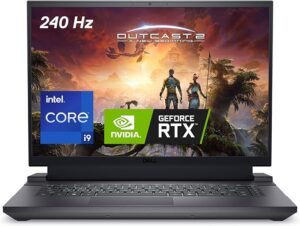
Why it’s great for engineering students: The Dell G15 delivers reliable performance for engineering applications at an approachable price point. It’s a bit more understated than many gaming laptops, making it suitable for professional settings.
Key Specifications:
- Processor: Intel Core i7-12700H (14 cores, up to 4.7 GHz)
- Graphics: NVIDIA RTX 4050 (6GB GDDR6)
- RAM: 16GB DDR5 (upgradable to 32GB)
- Storage: 512GB NVMe SSD (upgradable)
- Display: 15.6″ QHD (2560 x 1440) IPS, 165Hz, 100% sRGB
- Battery Life: Up to 6 hours
- Weight: 5.54 lbs (2.51 kg)
- Ports: 1x USB-C 3.2, 3x USB-A 3.2, HDMI 2.1, Ethernet, 3.5mm headphone jack
- Price: $1,099
Pros:
- Good performance for the price
- QHD display with 165Hz refresh rate
- Decent cooling system
- Relatively understated design for a gaming laptop
- Good serviceability and upgradability
Cons:
- Somewhat hefty
- Average battery life
- Base model comes with only 512GB storage
Real-world performance: The G15 performs admirably for engineering tasks at this price point. The QHD display provides more screen real estate for CAD work compared to Full HD alternatives, and the RTX 4050 handles modeling tasks well. For complex simulations, you might experience longer processing times compared to higher-end options, but for most undergraduate engineering workloads, it’s more than sufficient.
Budget-Friendly Laptops for Engineering Students (Under $1,000)
9. MSI Cyborg 15

Why it’s great for engineering students: The MSI Cyborg 15 offers impressive performance at a sub-$1000 price point, making it an excellent value for engineering students on a tight budget.
Key Specifications:
- Processor: Intel Core i7-12650H (10 cores, up to 4.7 GHz)
- Graphics: NVIDIA RTX 4050 (6GB GDDR6)
- RAM: 16GB DDR5 (upgradable to 32GB)
- Storage: 512GB NVMe SSD (upgradable)
- Display: 15.6″ Full HD (1920 x 1080) IPS, 144Hz
- Battery Life: Up to 5 hours
- Weight: 4.63 lbs (2.1 kg)
- Ports: 1x USB-C 3.2, 2x USB-A 3.2, HDMI 2.0, Ethernet, 3.5mm headphone jack
- Price: $899
Pros:
- Excellent performance-to-price ratio
- Latest generation RTX GPU
- Relatively lightweight for a gaming laptop
- Upgradeable RAM and storage
- Decent cooling for sustained performance
Cons:
- Average build quality with plastic chassis
- Battery life is modest
- Display is only Full HD
Real-world performance: The Cyborg 15 holds its own with engineering software, offering surprisingly good performance at this price point. The RTX 4050, while entry-level in the RTX lineup, still provides sufficient power for CAD work and basic simulations. The 144Hz display helps with smooth model manipulation.
The MSI Cyborg 15 ($999) is a cyberpunk-inspired gaming laptop that won’t destroy your wallet. It might look a little out of place in a lecture hall, but its Nvidia RTX 4050 GPU should provide more than enough horsepower for your engineering coursework.
10. Acer Nitro 5

Why it’s great for engineering students: The Acer Nitro 5 has long been a favorite in the budget gaming laptop space, offering solid performance at an affordable price point. It’s a practical choice for engineering students who need decent performance without breaking the bank.
Key Specifications:
- Processor: AMD Ryzen 5 7535HS (6 cores, up to 4.5 GHz)
- Graphics: NVIDIA RTX 3050 Ti (4GB GDDR6)
- RAM: 16GB DDR5 (upgradable to 32GB)
- Storage: 512GB NVMe SSD (upgradable, dual slots)
- Display: 15.6″ Full HD (1920 x 1080) IPS, 144Hz
- Battery Life: Up to 6 hours
- Weight: 5.51 lbs (2.5 kg)
- Ports: 1x USB-C 3.2, 3x USB-A 3.2, HDMI 2.0, Ethernet, 3.5mm headphone jack
- Price: $799
Pros:
- Affordable entry point for engineering students
- Good performance for the price
- Easily upgradeable RAM and storage
- Decent cooling system with dual fans
- Full array of ports including Ethernet
Cons:
- Bulkier than premium options
- Plastic build feels less premium
- Display is only 1080p
- RTX 3050 Ti is previous generation
Real-world performance: The Nitro 5 provides capable performance for CAD work and other engineering applications at its price point. While it won’t match the speed of higher-end options for complex simulations, it handles SolidWorks and AutoCAD adequately for most undergraduate work. The cooling system keeps thermals in check during extended usage, though the fans can get loud.
11. HP Victus 15

Why it’s great for engineering students: The HP Victus 15 offers a good balance of performance, build quality, and price. It’s a solid entry-level option for engineering students who need decent performance on a tight budget.
Key Specifications:
- Processor: Intel Core i5-13420H (8 cores, up to 4.6 GHz)
- Graphics: NVIDIA GTX 1650 (4GB GDDR6)
- RAM: 8GB DDR4 (upgradable to 32GB)
- Storage: 512GB NVMe SSD (upgradable)
- Display: 15.6″ Full HD (1920 x 1080) IPS, 144Hz
- Battery Life: Up to 6.5 hours
- Weight: 5.06 lbs (2.29 kg)
- Ports: 1x USB-C 3.2, 2x USB-A 3.2, HDMI 2.1, Ethernet, SD card reader, 3.5mm headphone jack
- Price: $699
Pros:
- Affordable price point
- Decent performance for basic CAD work
- Relatively understated design
- Good port selection including SD card reader
- Upgradeable RAM and storage
Cons:
- GTX 1650 is entry-level for engineering applications
- Base model comes with only 8GB RAM
- Build quality is average
- Display is only Full HD
Real-world performance: The Victus 15 is adequate for basic CAD work and programming tasks. The GTX 1650, while dated, can still handle AutoCAD and introductory SolidWorks projects. For more complex assemblies or simulations, you’ll experience some limitations. Upgrading the RAM to 16GB would be a worthwhile investment for better multitasking performance.
12. Lenovo IdeaPad Gaming 3

Why it’s great for engineering students: The IdeaPad Gaming 3 offers decent performance for entry-level engineering work at a very approachable price point, making it a practical choice for students on a tight budget.
Key Specifications:
- Processor: AMD Ryzen 5 6600H (6 cores, up to 4.5 GHz)
- Graphics: NVIDIA RTX 3050 (4GB GDDR6)
- RAM: 8GB DDR5 (upgradable to 16GB)
- Storage: 512GB NVMe SSD
- Display: 15.6″ Full HD (1920 x 1080) IPS, 120Hz
- Battery Life: Up to 5.5 hours
- Weight: 5.29 lbs (2.4 kg)
- Ports: 1x USB-C 3.2, 2x USB-A 3.2, HDMI 2.0, Ethernet, 3.5mm headphone jack
- Price: $649
Pros:
- Very affordable for a laptop with dedicated graphics
- Decent performance for entry-level CAD work
- Upgradeable RAM and storage
- Good port selection including Ethernet
- Relatively understated design
Cons:
- Base model has only 8GB RAM
- Build quality is average
- Display is only 120Hz
- Battery life is modest
Real-world performance: The IdeaPad Gaming 3 performs adequately for basic engineering tasks. It can handle AutoCAD 2D drawing and simpler 3D models in SolidWorks, though you’ll want to upgrade the RAM to 16GB for a smoother experience. For the price, it offers a good entry point for students just beginning their engineering journey.
Ultraportable Options Laptops for Engineering Students
13. Dell XPS 13 Plus
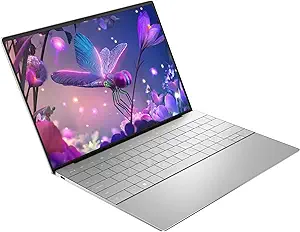
Why it’s great for engineering students: For students who prioritize portability and build quality while still needing decent performance for light to moderate engineering tasks, the XPS 13 Plus is an excellent choice.
Key Specifications:
- Processor: Intel Core Ultra 7 155H (16 cores)
- Graphics: Intel Arc Graphics (integrated)
- RAM: 16GB LPDDR5X (soldered)
- Storage: 512GB PCIe NVMe SSD
- Display: 13.4″ 3K (2880 x 1800) OLED touch display, 60Hz
- Battery Life: Up to 12 hours
- Weight: 2.71 lbs (1.23 kg)
- Ports: 2x Thunderbolt 4
- Price: $1,399
Pros:
- Extremely portable and lightweight
- Stunning OLED display
- Excellent build quality with premium materials
- Good battery life
- Powerful for an ultraportable
Cons:
- Limited to integrated graphics
- Not ideal for complex 3D modeling or simulations
- Minimal port selection
- Limited upgradeability
Real-world performance: The XPS 13 Plus handles 2D CAD work and programming tasks with ease. For basic 3D modeling in SolidWorks and AutoCAD, it performs adequately, though complex assemblies will push its limits. It’s ideal for students who need to take notes in class, work on programming assignments, and perform light CAD work while prioritizing portability.
14. Microsoft Surface Laptop 7
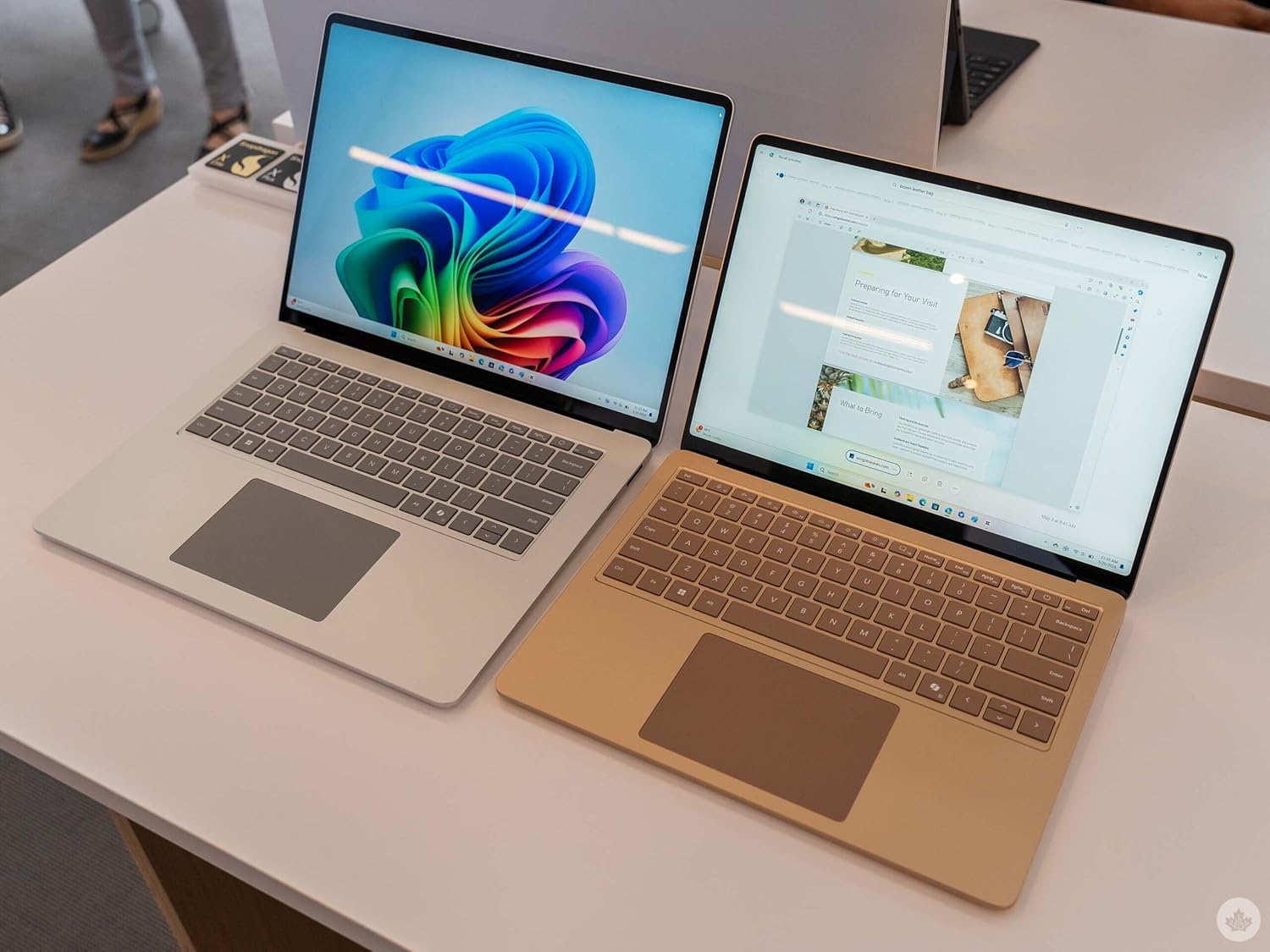
Why it’s great for engineering students: The Surface Laptop 7 combines excellent build quality, a stunning display, and impressive battery life in a highly portable package. It’s perfect for students who need a versatile device for general academic work with some capability for lighter engineering tasks.
Key Specifications:
- Processor: AMD Ryzen 7 8840U (8 cores, up to 5.1 GHz)
- Graphics: AMD Radeon Graphics (integrated)
- RAM: 16GB LPDDR5X (soldered)
- Storage: 512GB removable SSD
- Display: 13.8″ 2.K (2304 x 1536) touchscreen, 120Hz
- Battery Life: Up to 20 hours
- Weight: 2.96 lbs (1.34 kg)
- Ports: 1x USB-C 4.0, 1x USB-A 3.2, Surface Connect port, 3.5mm headphone jack
- Price: $1,299
Pros:
- Outstanding battery life
- Excellent build quality
- Beautiful high-resolution display
- Ultra-portable design
- Good keyboard and haptic touchpad
Cons:
- Limited to integrated graphics
- Not ideal for intensive 3D modeling
- Limited upgradeability
- Relatively sparse port selection
Real-world performance: The Surface Laptop 7 performs well for general academic work and programming. It can handle 2D CAD and basic 3D modeling, though it’s not suitable for complex assemblies or simulations. The incredible battery life makes it perfect for a full day of classes and study sessions without needing to find a power outlet.
The Microsoft Surface Laptop 7 offers an incredible 20 hours of battery life in our tests, making it perfect for long days on campus.
15. Lenovo ThinkPad X1 Carbon Gen 12
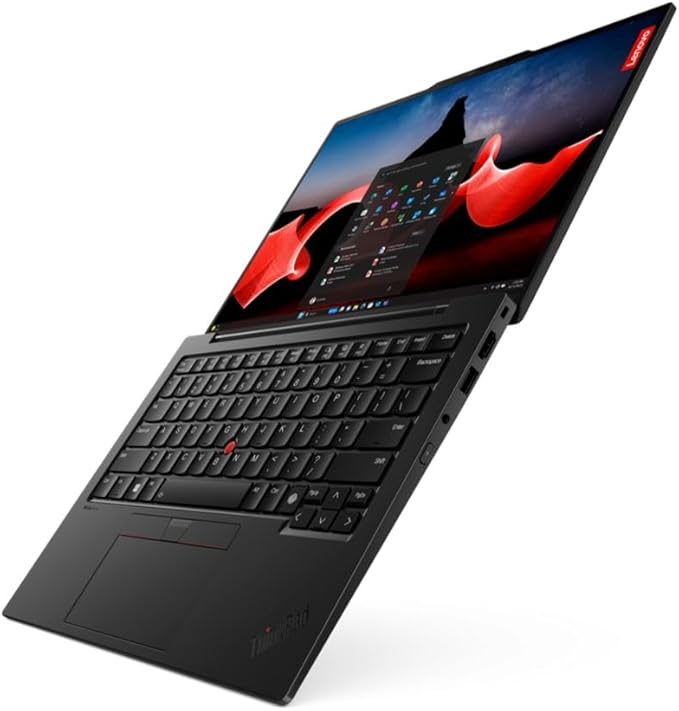
Why it’s great for engineering students: The ThinkPad X1 Carbon combines legendary durability, excellent keyboard, and good performance in an ultra-light package. It’s ideal for engineering students who need reliability and portability above maximum performance.
Key Specifications:
- Processor: Intel Core Ultra 7 155H (16 cores)
- Graphics: Intel Arc Graphics (integrated)
- RAM: 16GB LPDDR5X (soldered)
- Storage: 512GB PCIe Gen4 SSD
- Display: 14″ 2.8K (2880 x 1800) OLED, 120Hz
- Battery Life: Up to 14 hours
- Weight: 2.42 lbs (1.1 kg)
- Ports: 2x Thunderbolt 4, 2x USB-A 3.2, HDMI 2.0, 3.5mm headphone jack
- Price: $1,649
Pros:
- Incredibly light yet durable
- Excellent keyboard
- Great battery life
- Good port selection for an ultraportable
- Military-grade durability testing
Cons:
- Integrated graphics limit 3D performance
- Premium price tag
- Limited upgradeability
- Not ideal for complex engineering simulations
Real-world performance: The X1 Carbon handles daily academic tasks with ease and performs well for programming and 2D CAD work. It can manage basic 3D modeling, though complex assemblies will push its limits. The superb keyboard makes long coding sessions comfortable, and the exceptional portability means you’ll never hesitate to bring it to class.
Right now, I rate the Lenovo ThinkPad X1 Carbon as the best laptop for engineering students overall, thanks to its impressive power, sleek but durable build, and that iconic ThinkPad keyboard.
2-in-1 Options Laptops for Engineering Students
16. Microsoft Surface Laptop Studio 2
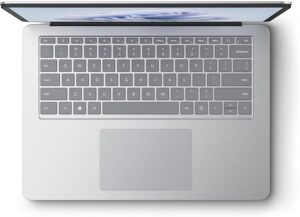
Why it’s great for engineering students: The Surface Laptop Studio 2 offers a unique form factor that transitions between laptop, stage, and tablet modes, making it versatile for various engineering tasks including note-taking, CAD work, and presentations.
Key Specifications:
- Processor: Intel Core i7-13700H (14 cores, up to 5.0 GHz)
- Graphics: NVIDIA RTX 4050 (6GB GDDR6)
- RAM: 16GB LPDDR5X (upgradable at purchase to 32GB)
- Storage: 512GB removable SSD
- Display: 14.4″ PixelSense Flow (2400 x 1600) touch display, 120Hz
- Battery Life: Up to 9 hours
- Weight: 4.37 lbs (1.98 kg)
- Ports: 2x Thunderbolt 4, 1x USB-A 3.1, Surface Connect port, 3.5mm headphone jack
- Price: $1,899
Pros:
- Versatile form factor with multiple positions
- Excellent display with 120Hz refresh rate
- Good performance with dedicated RTX graphics
- Precision haptic touchpad
- Surface Pen support for notes and sketching
Cons:
- Expensive
- Heavier than traditional laptops of similar size
- Limited upgradeability
Real-world performance: The Surface Laptop Studio 2 provides good performance for CAD work and light simulations. The RTX 4050 GPU, while not high-end, offers sufficient power for most undergraduate engineering tasks. The versatile form factor allows you to take handwritten notes directly on engineering diagrams and then flip back to laptop mode for CAD work.
17. HP Spectre x360 16

Why it’s great for engineering students: The Spectre x360 combines premium design, a vibrant display, and good performance in a versatile 2-in-1 form factor. It’s ideal for students who want the flexibility of both a laptop and tablet in one device.
Key Specifications:
- Processor: Intel Core Ultra 7 155H (16 cores)
- Graphics: Intel Arc Graphics (integrated)
- RAM: 16GB LPDDR5X (soldered)
- Storage: 1TB PCIe NVMe SSD
- Display: 16″ 3K+ (3072 x 1920) OLED touch display
- Battery Life: Up to 10 hours
- Weight: 4.3 lbs (1.95 kg)
- Ports: 2x Thunderbolt 4, 1x USB-A 3.2, HDMI 2.1, microSD card reader, 3.5mm headphone jack
- Price: $1,499
Pros:
- Stunning OLED display
- Versatile 2-in-1 design
- Premium build quality
- Good port selection
- Included active pen for note-taking
Cons:
- Limited to integrated graphics
- Not ideal for intensive 3D work
- Heavier than non-convertible laptops
- Limited upgradeability
Real-world performance: The Spectre x360 performs well for general academic tasks and basic engineering work. It handles 2D CAD and light 3D modeling adequately, though complex assemblies and simulations will be challenging. The 2-in-1 form factor is excellent for taking handwritten notes in class and annotating diagrams.
Workstation Alternatives Laptops for Engineering Students
18. Lenovo ThinkBook 16p Gen 5
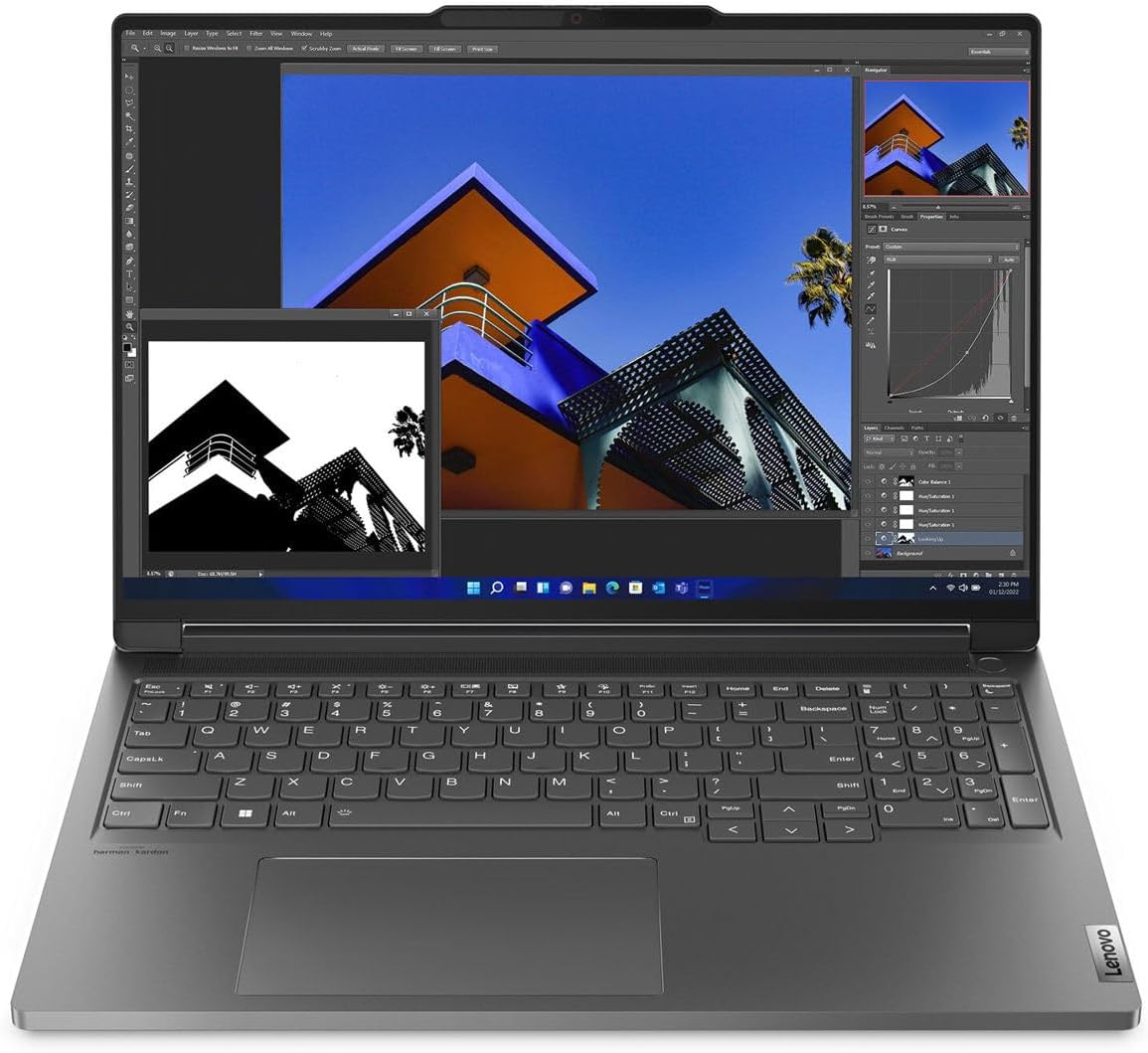
Why it’s great for engineering students: The ThinkBook 16p offers workstation-like performance in a more affordable package, making it an excellent choice for engineering students who need power but have budget constraints.
Key Specifications:
- Processor: AMD Ryzen 9 7940HS (8 cores, up to 5.2 GHz)
- Graphics: NVIDIA RTX 4060 (8GB GDDR6)
- RAM: 32GB DDR5 (soldered)
- Storage: 1TB PCIe Gen4 SSD (upgradable)
- Display: 16″ 2.5K (2560 x 1600) IPS, 165Hz, 100% sRGB
- Battery Life: Up to 8 hours
- Weight: 4.63 lbs (2.1 kg)
- Ports: 2x USB-C 3.2, 2x USB-A 3.2, HDMI 2.1, SD card reader, 3.5mm headphone jack
- Price: $1,499
Pros:
- Excellent performance for the price
- High-quality 16:10 display
- Good build quality
- Decent port selection
- Upgradable storage
Cons:
- RAM is soldered
- Not as powerful as true workstations
- Design is less premium than flagship models
Real-world performance: The ThinkBook 16p handles CAD software and simulations very well for its price range. The combination of a powerful Ryzen processor and RTX 4060 GPU provides smooth performance in SolidWorks and other engineering applications. The 16:10 display offers more vertical space for CAD interfaces.
19. HP ZBook Firefly G10
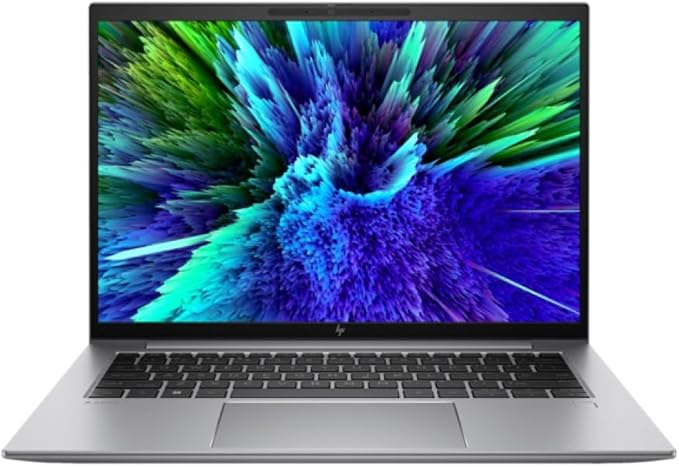
Why it’s great for engineering students: The ZBook Firefly offers professional workstation features in a more portable and affordable package compared to high-end workstations, making it a good middle ground for engineering students.
Key Specifications:
- Processor: Intel Core i7-1355U (10 cores, up to 5.0 GHz)
- Graphics: NVIDIA RTX 500 Ada Generation (4GB GDDR6)
- RAM: 16GB DDR5 (upgradable to 64GB)
- Storage: 512GB PCIe Gen4 SSD (upgradable)
- Display: 16″ WUXGA (1920 x 1200) IPS
- Battery Life: Up to 11 hours
- Weight: 3.61 lbs (1.64 kg)
- Ports: 2x Thunderbolt 4, 2x USB-A 3.2, HDMI 2.0, 3.5mm headphone jack
- Price: $1,399
Pros:
- Professional workstation graphics
- ISV certifications for engineering software
- Lighter than many workstations
- Good battery life
- MIL-STD durability testing
Cons:
- Not as powerful as full workstations
- Base display is only 1920×1200
- Limited upgradeability compared to larger workstations
Real-world performance: The ZBook Firefly provides solid performance for CAD and light simulation work, with its workstation-grade RTX 500 Ada GPU optimized for professional applications. While not as powerful as the larger ZBook models, it offers a good balance of performance, portability, and battery life for engineering students.
20. Framework Laptop 16
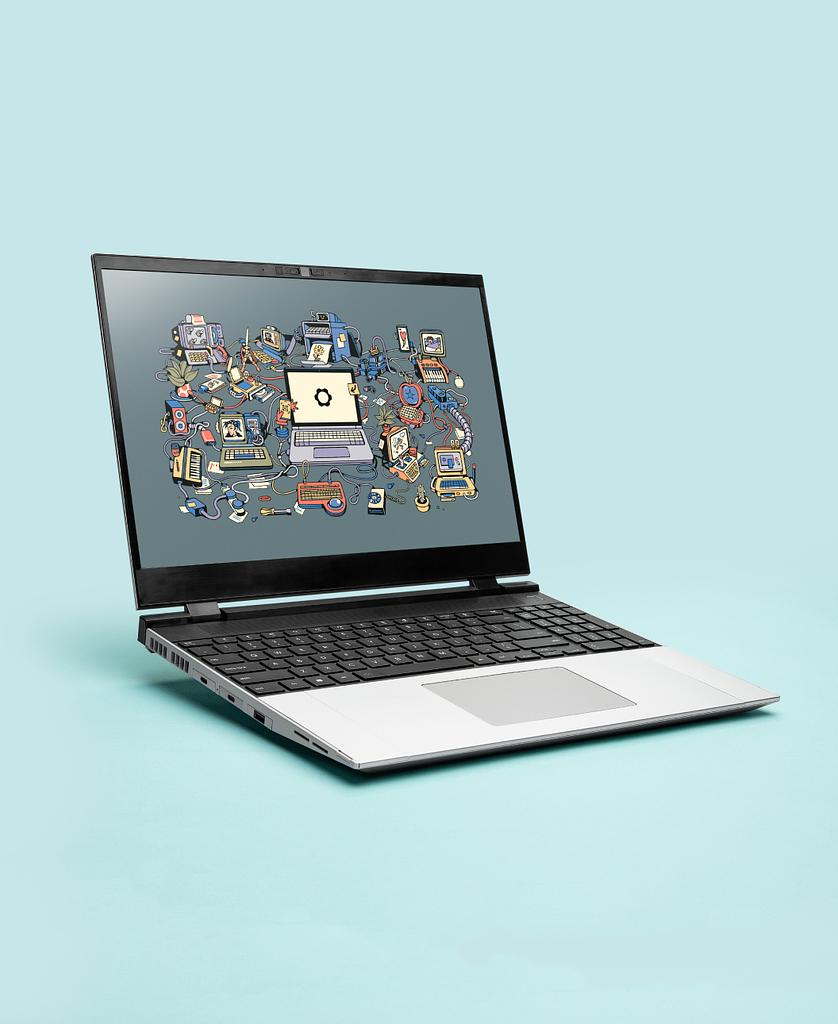
Why it’s great for engineering students: The Framework Laptop 16 offers unprecedented upgradeability and repairability, making it an excellent long-term investment for engineering students. Its modular design allows you to upgrade components as your needs change throughout your education.
Key Specifications:
- Processor: AMD Ryzen 7 7840HS (8 cores, up to 5.1 GHz)
- Graphics: AMD Radeon 780M (integrated) with optional AMD Radeon RX 7700S (8GB GDDR6) expansion card
- RAM: 32GB DDR5 (user replaceable, 2 SODIMM slots)
- Storage: 1TB PCIe Gen4 SSD (user replaceable, 2 M.2 slots)
- Display: 16″ 2560 x 1600 IPS, 165Hz
- Battery Life: Up to 8 hours
- Weight: 4.63 lbs (2.1 kg)
- Ports: Fully customizable with expansion bay system
- Price: $1,699 (base config with expansion card)
Pros:
- Unparalleled upgradeability and repairability
- Customizable port selection
- Option to add discrete graphics card as needed
- High-quality build materials
- Strong sustainability credentials
Cons:
- Higher initial cost
- Not as refined as some competing laptops
- Battery life is average
- Relatively new company with fewer service centers
Real-world performance: The Framework Laptop 16 with the optional graphics expansion card performs well for CAD and engineering applications. Its modular nature means you can start with a more basic configuration and upgrade components as your coursework becomes more demanding, potentially saving money in the long run.
Important Considerations for Mechanical Engineering Students
Software Compatibility
Before purchasing, check your department’s specific software requirements:
- Windows vs. macOS: Most engineering software (SolidWorks, ANSYS, AutoCAD) is designed for Windows. While some applications offer Mac versions, many don’t. If you choose a Mac, be prepared to run Windows via Boot Camp or virtualization, which may affect performance.
- Driver Certification: Some software performs better with certified graphics drivers. NVIDIA’s professional RTX series (formerly Quadro) and AMD’s Radeon Pro have special drivers optimized for CAD applications.
Future-Proofing Your Investment
Engineering software becomes more demanding with each new version:
- Upgradeability: Consider laptops with accessible RAM and storage slots for future upgrades.
- Performance Headroom: Buying a laptop that exceeds your current needs helps ensure it remains useful throughout your degree program.
- Warranty and Support: Extended warranties can be worthwhile for laptops that will see heavy daily use over multiple years.
Portability vs. Performance Trade-offs
Consider your daily routine:
- Campus Mobility: If you’ll be moving between multiple buildings daily, lighter laptops (under 4.5 lbs) may be worth the performance trade-off.
- Home Base: If you’ll mainly use your laptop in your dorm or apartment, a more powerful but heavier model might be preferred.
- External Display: Consider connecting to an external monitor for detailed CAD work when at your desk.
Cooling and Thermal Performance
Engineering applications can push laptops to their thermal limits:
- Cooling Design: Look for laptops with robust cooling systems if you’ll be running intensive simulations.
- Cooling Pads: An external cooling pad can help maintain performance during long rendering or simulation sessions.
- Thermal Throttling: Cheaper laptops may throttle performance significantly under sustained loads.
Software Compatibility and Operating Systems
Choosing a laptop for mechanical engineering studies means looking at software and operating systems. The main ones are Windows, macOS, and Linux.
Windows vs. MacOS for Engineering
Windows laptops are top picks for engineering students. Most engineering software works well on Windows. You can also customize your laptop to fit your needs.
Windows is familiar to many, making it a popular choice. It’s easy to use and widely adopted.
Linux Compatibility
Linux is also used in engineering, especially for open-source software. It’s a good choice for those watching their budget. FreeCAD and OpenFOAM work well on Linux.
But, learning Linux takes time. Some engineering apps might not work on Linux.
Software License Considerations
Think about software licenses when picking an operating system. Some software costs a lot, and student discounts can help. Check what software you need and how much it costs.
FAQS About Best Laptops for Mechanical Engineering Students
What are the key hardware specifications for a laptop suited for mechanical engineering students?
For mechanical engineering, laptops need strong processors, lots of RAM, and fast SSDs. They also need dedicated graphics cards. This setup is key for running complex CAD and 3D modeling tools.
Why is graphics processing power important for mechanical engineering laptops?
Graphics processing power is crucial for mechanical engineering laptops because it enables smooth 3D modeling, CAD rendering, and simulation performance, ensuring efficient workflows and accurate visualizations in complex design environments.
What laptop do most engineering students use?
Most engineering students prefer laptops like the Dell XPS 15, MacBook Pro (M3 or M2), or Lenovo ThinkPad X1 Carbon due to their powerful processors, reliable performance, long battery life, and compatibility with engineering software.
Does mechanical engineering require a good laptop?
Yes, mechanical engineering requires a good laptop with strong processing power, sufficient RAM, and a dedicated graphics card to efficiently run CAD software, simulations, and multitasking workloads.
What connectivity options are important for engineering laptops?
Engineering laptops need many connectivity options. This includes lots of USB ports, Thunderbolt, HDMI, and docking station support. These features help with using various peripherals and external displays smoothly.
What laptop should an engineering student buy?
An engineering student should buy a laptop with a fast processor (Intel i7 or Ryzen 7), 16GB RAM, SSD storage, and a dedicated GPU for CAD or simulation software.
Is i5 or i7 better for engineering?
An Intel i7 is better for engineering due to higher core counts, faster processing speeds, and superior multitasking—ideal for CAD, simulations, and heavy software.
How much RAM do you need for an engineering laptop?
16GB of RAM is ideal for most engineering tasks, including CAD, simulations, and coding. However, 32GB is recommended for heavy multitasking, 3D modeling, or large simulations to ensure smooth performance.
Final Thoughts
The “best” laptop for mechanical engineering depends on your specific needs, budget, and preferences. Here’s a summary to help you decide:
- High-Performance Need, Flexible Budget: Dell XPS 16, Lenovo ThinkPad P16, or ASUS ProArt StudioBook
- Balance of Performance and Value: Lenovo Legion 5 Pro or ASUS ROG Zephyrus G14
- Tight Budget: MSI Cyborg 15 or Acer Nitro 5
- Maximum Portability: Dell XPS 13 Plus or Lenovo ThinkPad X1 Carbon
- Versatility with Pen Support: Microsoft Surface Laptop Studio 2 or HP Spectre x360
- Future-Proof Investment: Framework Laptop 16
Remember that engineering is about solving problems, and sometimes that means making smart compromises. A laptop that balances your specific needs with your budget constraints will serve you well throughout your engineering education.
Whatever laptop you choose, make sure it meets the minimum requirements for the specific software you’ll be using in your program. When in doubt, consult with your department for their recommendations—they often have insights into which machines work best with their curriculum.
Happy engineering, and may your renders always complete quickly!





